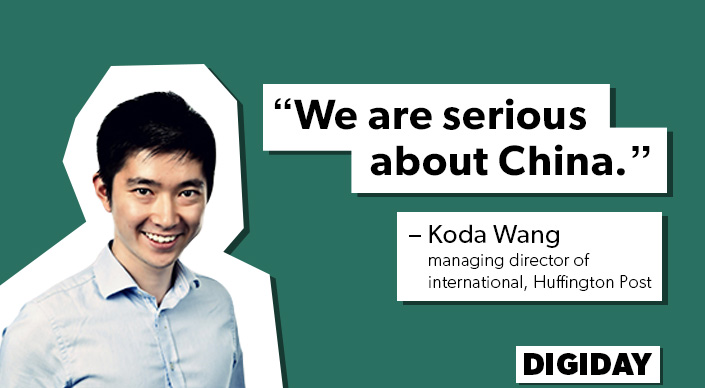
Digital publishers don’t get much more international than The Huffington Post. Its editor-in-chief, Arianna Huffington, is Greek-American, CEO Jimmy Maymann is Danish, and its chief technical officer, Otto Toth, is Hungarian.
HuffPo’s business strategy is similarly globally minded. The Huffington Post launched its first international edition, HuffPost Canada, in 2011, and has since then expanded its footprint to 13 other markets — including France, Japan, Brazil and, mostly recently, Australia. It is now planning an expansion into China.
Getting all that done in four years has been no easy task, but The Huffington Post has learned a lot since its initial move up north. “One thing that I’ve come to understand is that every single market is seeing many of the same trends in things like programmatic, mobile, social and video. The difference is that they’re just at different schedules,” said general manager of international Koda Wang.
Wang spoke to Digiday about how The Huffington Post approaches new markets, how it adapts its formula for each new country, and why expanding from the U.S. to the U.K. is more complicated than publishers initially think.
What’s the first thing The Huffington Post thinks about when moving to a new market?
From the beginning, we look at macroeconomic factors — things like Internet penetration, smartphone usage and online news consumption. They give us a general sense of how healthy the market is for an online news site. If a digital ad market is nonexistent, it’s much less attractive than if there’s a growing one.
What’s been the most interesting market expansion on so far?
They’re all interesting for different reasons. South Korea, for example, is interesting because it’s an extremely mobile market — even more mobile than the U.S. You know the saying about the future and past both being in the present, just geographically distributed? South Korea is a vision of the future today. In South Korea, over 80 percent of our unique visitors are on mobile. When a place is that mobile-centric, it changes your entire sales team and newsroom structures. It’s optimizing for all sorts of different mobile platforms.
You’ve expanded to India, which is also very mobile but also far less developed.
One thing we had to pay attention to in India was page performance. India is a country where most connections are on 2G and 3G networks. If you have a slow site — which a lot of U.S. sites in India do — you will die as a publisher and a website. No one there is going to wait 45 seconds for your page to load.
How about content? How does that change?
With our German site we go a lot stronger on lifestyle and parenting coverage. It’s a bigger vertical than politics there for us. In Italy, our editorial director is a well-known investigative journalist, so we’re much better known for our politics coverage there.
What about the U.K.? It seems like publishers are often surprised by the work it takes to make content relevant here.
Even if you look at the U.S. versus Canada and the U.K., there are big differences. With HuffPost Canada, we use a lot more content from the U.S., and it’s easily consumed there. In the U.K., on the other hand, consumers really want content that was made exclusively for them.
BuzzFeed found that it couldn’t get away with as much nostalgia in the U.K. as it could in the U.S.
Yeah. A lot of publishers at first think, “all these countries speak English, so why not just do the same stuff there.” But it’s more nuanced than that.
Is that why you partner with local media companies?
We think that together we can do something bigger than either of us can do alone. We take our technology platform and content and digital savvy and combine with partners’ expertise and commercial capabilities. The goal is always to create something distinct in the market that’s still in-sync with our brand.
And then there’s China. What’s the progress there?
We are serious about China. To be successful there you have to do more than put a site up — you have to understand Chinese consumers, have good relationships with Chinese advertisers and understand the incumbent players. We talk about Facebook, Twitter and Google here, but in China is Baidu, Alibaba and Tencent.

How do you get around the Great Firewall, though? They’re not exactly journalism-friendly.
The center of gravity for our China site will be lifestyle. Lifestyle has been huge for HuffPost globally, and it’s the most promising area where we can win in China. There’s a dramatically growing middle class who are hungry for that type of content.
So what’s the difference between a publisher that successfully expands and one that doesn’t?
It’s hard to say. You see a lot of publishers entering counties but never getting off the ground and can’t get beyond single-digit audience numbers. It isn’t one variable that makes or breaks. For some publishers, it might be because they don’t have a lot of local content, so the site doesn’t seem relevant; others, they don’t combine that content with the ability to distribute it effectively. Others might not have a unified technology platform like ours, which lets someone working at HuffPo Brazil see what’s trending in HuffPo Japan.
More in Media

Digiday Scorecard: Publishers’ rate Big Tech’s AI licensing deals
Digiday has compiled a scorecard grading AI platforms to make sense of the growing number of players in the AI content licensing market.

Publishers are hunting for AI prompt data — now they’re starting to get it from third-party companies
Publishers are finally gaining some visibility into AI search, as new prompt data tools crack open a black box.

Digiday+ Research: Publishers’ growing focus on video doesn’t translate to social platforms
Major publishers have made recent investments in vertical video, but that shift is not carrying over to social media platforms.





